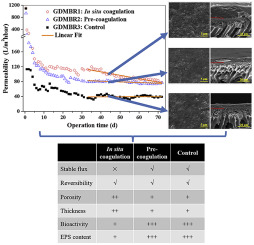当前位置:
X-MOL 学术
›
Water Res.
›
论文详情
Our official English website, www.x-mol.net, welcomes your
feedback! (Note: you will need to create a separate account there.)
In situ coagulation versus pre-coagulation for gravity-driven membrane bioreactor during decentralized sewage treatment: Permeability stabilization, fouling layer formation and biological activity
Water Research ( IF 11.4 ) Pub Date : 2017-09-18 , DOI: 10.1016/j.watres.2017.09.027 An Ding , Jinlong Wang , Dachao Lin , Xiaobin Tang , Xiaoxiang Cheng , Guibai Li , Nanqi Ren , Heng Liang
Water Research ( IF 11.4 ) Pub Date : 2017-09-18 , DOI: 10.1016/j.watres.2017.09.027 An Ding , Jinlong Wang , Dachao Lin , Xiaobin Tang , Xiaoxiang Cheng , Guibai Li , Nanqi Ren , Heng Liang

|
Gravity-driven membrane filtration systems are promising for decentralized sewage treatment due to their low energy consumption and low maintenance. However, the low stable permeability/flux is currently limiting their wider application. With the ultimate goal of increasing permeability, the aim of this study was to evaluate the effect of coagulation (in situ coagulation and pre-coagulation) on the performance of a gravity-driven membrane bioreactor (GDMBR) during treatment of synthetic sewage. Results show that in situ coagulation significantly increased permeability (more than two-fold); however, no stabilization of permeability occurred over the whole operation, when non-coagulated and pre-coagulated reactors were compared. The high permeability observed was attributed to the accumulated aluminium floc in the reactor, which prevented formation of fluorescent microbial metabolites (aromatic and tryptophan proteins, as well as fulvic acids), and further avoided membrane pore blocking. In addition, the surface porosity of the fouling layer was improved (from 11.2% to 32.4% for non-coagulated and in situ coagulated reactors). The unstable permeability was possibly associated with lower biological processes within the fouling layer. These might include lower adenosine triphosphate (ATP) content and lower fluorescent metabolites from the extracellular polymeric substances (EPS) caused by the accumulated Al (compared with the control). On the other hand, pre-coagulation improved the level of stable permeability compared with the control (80 versus 40 L/m2 h bar), mainly because pre-coagulation decreased the EPS content and also maintained high ATP content of the fouling layer. In addition, both coagulation processes reduced the total filtration resistance, mainly the hydraulically reversible resistance and cake layer resistance, which could lower the cleaning frequency. Overall, coagulation could greatly increase the removal efficiency and improve the GDMBR permeability, which would make the process suitable for decentralized wastewater treatment.
中文翻译:

分散污水处理过程中重力驱动膜生物反应器的原位凝结与预凝结:渗透稳定性,结垢层形成和生物活性
重力驱动的膜过滤系统因其低能耗和低维护而有望用于分散式污水处理。但是,低的稳定渗透率/通量目前限制了它们的广泛应用。最终目的是提高渗透性,本研究的目的是评估在合成污水处理过程中,混凝(原位混凝和预混凝)对重力驱动膜生物反应器(GDMBR)性能的影响。结果表明,原位凝血显着提高了通透性(超过两倍);然而,当比较未凝结的和预凝结的反应器时,在整个操作过程中渗透率没有稳定。观察到的高渗透性归因于反应器中积聚的铝絮凝物,从而阻止了荧光微生物代谢物(芳香族和色氨酸蛋白以及黄腐酸)的形成,并进一步避免了膜孔的阻塞。此外,结垢层的表面孔隙率得到了改善(对于非凝结和原位,结垢率从11.2%增至32.4%凝结的反应器)。不稳定的渗透性可能与结垢层内较低的生物过程有关。这些可能包括较低的三磷酸腺苷(ATP)含量和由积累的Al引起的来自细胞外聚合物(EPS)的较低荧光代谢物(与对照相比)。另一方面,与对照相比(80 L / m 2与40 L / m 2相比),预混凝提高了稳定的渗透性水平。h bar),主要是因为预凝结降低了EPS含量,并且还保持了污垢层的高ATP含量。另外,这两种凝结工艺均降低了总过滤阻力,主要是水力可逆阻力和滤饼层阻力,这可能会降低清洗频率。总体而言,混凝可以大大提高去除效率并提高GDMBR的渗透性,这将使该工艺适合于分散式废水处理。
更新日期:2017-09-19
中文翻译:

分散污水处理过程中重力驱动膜生物反应器的原位凝结与预凝结:渗透稳定性,结垢层形成和生物活性
重力驱动的膜过滤系统因其低能耗和低维护而有望用于分散式污水处理。但是,低的稳定渗透率/通量目前限制了它们的广泛应用。最终目的是提高渗透性,本研究的目的是评估在合成污水处理过程中,混凝(原位混凝和预混凝)对重力驱动膜生物反应器(GDMBR)性能的影响。结果表明,原位凝血显着提高了通透性(超过两倍);然而,当比较未凝结的和预凝结的反应器时,在整个操作过程中渗透率没有稳定。观察到的高渗透性归因于反应器中积聚的铝絮凝物,从而阻止了荧光微生物代谢物(芳香族和色氨酸蛋白以及黄腐酸)的形成,并进一步避免了膜孔的阻塞。此外,结垢层的表面孔隙率得到了改善(对于非凝结和原位,结垢率从11.2%增至32.4%凝结的反应器)。不稳定的渗透性可能与结垢层内较低的生物过程有关。这些可能包括较低的三磷酸腺苷(ATP)含量和由积累的Al引起的来自细胞外聚合物(EPS)的较低荧光代谢物(与对照相比)。另一方面,与对照相比(80 L / m 2与40 L / m 2相比),预混凝提高了稳定的渗透性水平。h bar),主要是因为预凝结降低了EPS含量,并且还保持了污垢层的高ATP含量。另外,这两种凝结工艺均降低了总过滤阻力,主要是水力可逆阻力和滤饼层阻力,这可能会降低清洗频率。总体而言,混凝可以大大提高去除效率并提高GDMBR的渗透性,这将使该工艺适合于分散式废水处理。











































 京公网安备 11010802027423号
京公网安备 11010802027423号